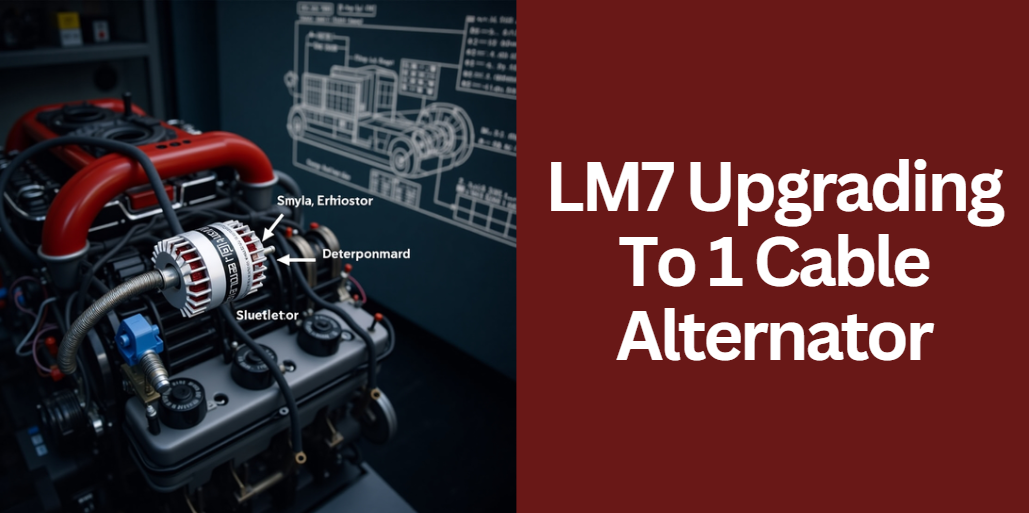Ultimate Guide to LM7 Upgrading To 1 Cable Alternator
The LM7 engine is well-known for its robust performance, yet some stock features, such as the traditional multi-cable alternator system, can become limiting under high-load conditions. This article is designed to provide you with comprehensive insights into the LM7 Upgrading To 1 Cable Alternator process.
You will learn not only why this upgrade can be beneficial but also the detailed steps involved in implementing it. Our aim is to offer a unique resource that covers every aspect of the upgrade—from planning and preparation to installation, troubleshooting, and long-term maintenance.
Understanding the Basics
The LM7 Engine and Its Electrical System
The LM7 engine has earned a reputation for its power and performance; however, its original alternator setup, which uses multiple cables, can sometimes lead to voltage drop issues and wiring complexity. Many owners have found that the upgrade to a single-cable system simplifies wiring, reduces the risk of connection failures, and ultimately improves the alternator’s efficiency.
Alternator Fundamentals
An alternator is a critical component in any engine, converting mechanical energy into electrical energy to power the vehicle and charge the battery. The traditional multi-cable system divides responsibilities among various cables, but with LM7 Upgrading To 1 Cable Alternator, all the necessary electrical functions are consolidated into one primary cable. This not only enhances reliability but also eases the troubleshooting process in case of issues.
Why Upgrade to a 1 Cable Alternator?
Switching to a one-cable alternator system offers multiple advantages. The simplification of wiring results in fewer connection points, reducing the possibility of corrosion and voltage drops. Additionally, this streamlined system is especially beneficial for high-performance and heavy-load applications.
The efficiency gains can lead to a more robust charging process, making it easier to handle increased electrical demands.To illustrate these benefits, consider the following table comparing the stock multi-cable system with the single-cable upgrade:
| Feature | Stock Multi-Cable Alternator | LM7 Upgrading To 1 Cable Alternator |
|---|---|---|
| Wiring Complexity | High | Low |
| Connection Points | Multiple | Single |
| Voltage Drop Risk | Higher | Lower |
| Installation Difficulty | Moderate to High | Simplified |
| Maintenance Requirements | Frequent | Minimal |
Preparation and Planning
Before you begin the LM7 Upgrading To 1 Cable Alternator process, it is essential to assess your current vehicle setup and gather the necessary tools and parts. Start by inspecting your electrical system and identifying any signs of wear or inefficiency. This proactive approach helps ensure that the upgrade will be effective and that no additional issues will interfere with the process.
Checklist for Preparation
- Vehicle Assessment:
Examine your current alternator and wiring setup to determine if there are any pre-existing issues that need addressing. Make note of the connections and their functions. - Tools and Materials:
Prepare a comprehensive list of tools such as wrenches, a multimeter, and screwdrivers. Additionally, source the specific parts or conversion kits required for the LM7 Upgrading To 1 Cable Alternator process. - Budget Considerations:
Plan your budget by listing the cost of necessary tools, replacement parts, and any potential professional assistance if needed. - Safety Measures:
Ensure that you have a well-ventilated workspace, proper safety gear, and that you disconnect the battery before starting any work.
Step-by-Step Installation Guide
Pre-Installation Checklist
Before diving into the installation, it’s vital to disconnect your vehicle’s battery and document the existing wiring configuration. This step ensures that you can refer back to the original setup if needed.
Removing the Stock Alternator System
Start by carefully removing the stock alternator, paying close attention to the multiple cables and connections. Detailed photos and diagrams can be especially helpful during this stage to serve as a reference for reinstallation or troubleshooting.
Preparing the New 1 Cable Alternator
Once the old system is removed, you will need to adapt the wiring harness to accommodate the new single cable. This often involves minor modifications to the existing brackets and connectors to ensure a secure fit. A hands-on approach is required here, as every LM7 engine may have slight variances.
Installation Process
The installation of the new alternator involves aligning it correctly with the engine and ensuring that the single cable is connected to all the necessary electrical points, including grounding and field excitation. Detailed steps include:
- Mounting the alternator using the adapted bracket.
- Connecting the consolidated cable securely to the battery and engine control modules.
- Verifying that all connections are tight and free from corrosion.
A step-by-step list can help you keep track of the process:
- Disconnect the battery.
- Remove the existing alternator and document wiring.
- Prepare the new alternator and modify the bracket if needed.
- Install the new alternator and secure it firmly.
- Connect the single cable to the appropriate power and grounding points.
- Reconnect the battery and perform diagnostics.
Post-Installation Testing and Calibration
After installation, it is crucial to test the new setup thoroughly. Reconnect the battery and use a multimeter to check voltage outputs and ensure that the alternator is charging efficiently. This final stage is essential to identify any issues early on and correct them promptly.
Troubleshooting and Problem Solving
Despite careful installation, challenges may arise. Common issues include wiring faults or loose connections that can lead to improper charging. If you encounter problems, recheck each connection and refer to the wiring diagrams. In cases where the troubleshooting process becomes too complex, seeking professional help can be the best course of action.
Optimizing and Enhancing Performance
Once the LM7 Upgrading To 1 Cable Alternator upgrade is complete, consider fine-tuning your vehicle’s overall electrical system. Enhancing performance may involve integrating additional aftermarket parts or modifications that further boost the charging capacity.
Real-world case studies from fellow enthusiasts can provide valuable insights into optimizing your setup for various performance demands.
Maintenance and Long-Term Care
Maintaining your upgraded alternator is vital for long-term performance. Regular inspections, cleaning of the connection points, and monitoring voltage levels will ensure that your new setup remains reliable over time. Establishing a routine maintenance schedule can help preempt potential issues and extend the lifespan of your alternator.
Maintenance Tips Table
| Maintenance Task | Frequency | Purpose |
|---|---|---|
| Visual Inspection | Monthly | Check for wear and corrosion |
| Voltage Testing | Quarterly | Ensure proper charging output |
| Cleaning of Connection Points | As Needed | Prevent buildup of dirt/corrosion |
| Professional Diagnostics Check | Annually | Confirm overall system performance |
Frequently Asked Questions (FAQ)
FAQ 1: Do I need to modify my engine control unit (ECU) for this upgrade?
Typically, the ECU does not require modifications when switching to a single-cable alternator system. However, some enthusiasts recommend a brief recalibration after installation to ensure that the new charging profile is accurately interpreted by the vehicle’s onboard diagnostics.
FAQ 2: How does this upgrade impact the vehicle’s overall fuel efficiency?
While the primary goal of the upgrade is to improve electrical efficiency and reliability, some users have noticed minor improvements in fuel efficiency. This is likely due to a reduction in energy loss from voltage drop, though the effect is generally subtle and secondary to performance gains.
FAQ 3: Are there compatibility concerns with other aftermarket parts when performing this upgrade?
The LM7 Upgrading To 1 Cable Alternator modification is designed to integrate smoothly with most aftermarket electrical components. Nonetheless, it is advisable to verify that any additional modifications, such as upgraded batteries or performance chips, are compatible with the new wiring setup to avoid potential conflicts.
FAQ 4: Which brands or conversion kits are recommended for a reliable upgrade?
While several reputable conversion kits are available, recommendations can vary based on regional availability and personal preferences. Many experts suggest choosing kits that have strong community reviews and come with detailed installation instructions to ensure consistency and reliability in the upgrade process.
FAQ 5: Will this upgrade affect the vehicle’s resale value or warranty status?
Modifying the alternator system can have mixed effects on resale value. Enthusiasts who value performance improvements may see it as a benefit, while others may view it as a deviation from factory specifications. Additionally, such modifications are typically not covered by manufacturer warranties, so it is important to consider potential implications before proceeding.
Conclusion
In summary, the LM7 Upgrading To 1 Cable Alternator upgrade offers a significant improvement in reliability, efficiency, and ease of maintenance for your LM7 engine. By simplifying the wiring, reducing voltage drop, and offering a straightforward installation process, this upgrade not only enhances performance but also provides long-term benefits.
Whether you are a seasoned mechanic or a DIY enthusiast, this comprehensive guide is designed to equip you with the knowledge needed to successfully complete the upgrade and enjoy a more robust electrical system.
More Posts
The Ultimate Guide to 60s Baseball Silhouette Coins Topps
The Ultimate Guide to Vintage Green Coke Bottle Pennsboro WV 1951 Value
Does A 1015 Subaru Forester Have A Oil Life Monitor? – A Comprehensive Guide
Comprehensive Guide to the Ardwolf 2-In-1 Smoke And Co Detector
Comprehensive Guide to Andirz_Mal22_Traitttrackerinjector_v.2.0.0





